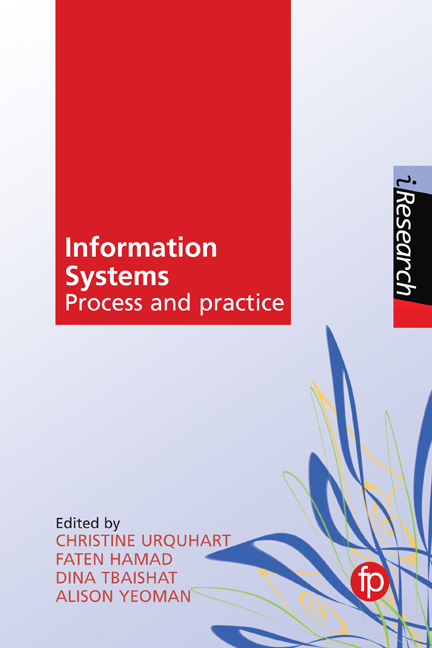Book contents
- Frontmatter
- Contents
- List of tables and figures
- Series editor's foreword
- About the authors
- 1 Introduction
- 2 Approaches to information architecture
- 3 Taxonomy testing for information architecture
- 4 The enterprise website and its information structures
- 5 Analysing activities, roles and processes
- 6 Libraries and the organisation of library processes – a history of operational research, and the use of process modelling
- 7 Using Riva process modelling to study book acquisition in academic libraries
- 8 Workflow analysis and process mapping in US academic libraries
- 9 A theoretical framework for designing and evaluating semi-structured document triage interfaces
- 10 Resource discovery case studies
- 11 Increasing social connection through a community-of-practice-inspired design
- 12 Methods for studying information provision, networking and communication in patient support groups
- 13 Health information systems: clinical data capture and document architecture
- 14 Producing systematic reviews and getting evidence to the clinician
- Index
10 - Resource discovery case studies
Published online by Cambridge University Press: 08 June 2018
- Frontmatter
- Contents
- List of tables and figures
- Series editor's foreword
- About the authors
- 1 Introduction
- 2 Approaches to information architecture
- 3 Taxonomy testing for information architecture
- 4 The enterprise website and its information structures
- 5 Analysing activities, roles and processes
- 6 Libraries and the organisation of library processes – a history of operational research, and the use of process modelling
- 7 Using Riva process modelling to study book acquisition in academic libraries
- 8 Workflow analysis and process mapping in US academic libraries
- 9 A theoretical framework for designing and evaluating semi-structured document triage interfaces
- 10 Resource discovery case studies
- 11 Increasing social connection through a community-of-practice-inspired design
- 12 Methods for studying information provision, networking and communication in patient support groups
- 13 Health information systems: clinical data capture and document architecture
- 14 Producing systematic reviews and getting evidence to the clinician
- Index
Summary
COMMENTARY: CHRISTINE URQUHART
This chapter discusses three Jisc-funded resource discovery projects at academic libraries throughout the UK: a photograph project at Queen's University Belfast, the use of the balanced value impact model for stakeholder and audience analysis at Middlesex University's Museum of Domestic Design and Architecture, and building a better content management system at the Museum of English Rural Life (MERL) and Special Collections at the University of Reading. This tries to meet the needs of casual visitors, and bring more visitors to the site.
The Queen's University project was designed jointly by library staff and the academics from the School of Modern History and Anthropology. One of the reasons for this collaborative approach was the benefit of dissemination among academic networks by academics, so project outputs could be used and reviewed by faculty elsewhere. Importantly, the project outputs were cited in other publications, which in turn led to discovery of resources by other academics and doctoral students. In a comparison of the referencing behaviour of doctoral students and faculty members, Lariviere, Sugimoto and Bergeron (2013) found that doctoral students generally tend to cite more documents per article than do faculty, and that the literature that they cite is generally more recent. This is not surprising, but what was surprising was that faculty in social sciences and the humanities were far more likely to cite theses than the doctoral students. The authors suggest that through their academic networks, including the examination process for doctoral students, faculty are likely to be aware of relevant research by doctoral students elsewhere – and such research may take a long time to get published in books or journals, if it is published at all.
Academic partners in the project added annotations for the photographs. Roles and responsibilities for the various elements of the work could probably be fairly well defined. When reviewing the history of library–faculty collaboration, Cunningham (2010) suggests that digital humanities projects present good opportunities for collaboration as the projects may be multidisciplinary – or at least produce material that is of interest to several fields of research. Collaboration between faculty and library staff is essential as digital humanities scholars may not appreciate the importance of guidelines for preservation – nor the need for metadata for preservation.
- Type
- Chapter
- Information
- Information SystemsProcess and Practice, pp. 171 - 184Publisher: FacetPrint publication year: 2017



